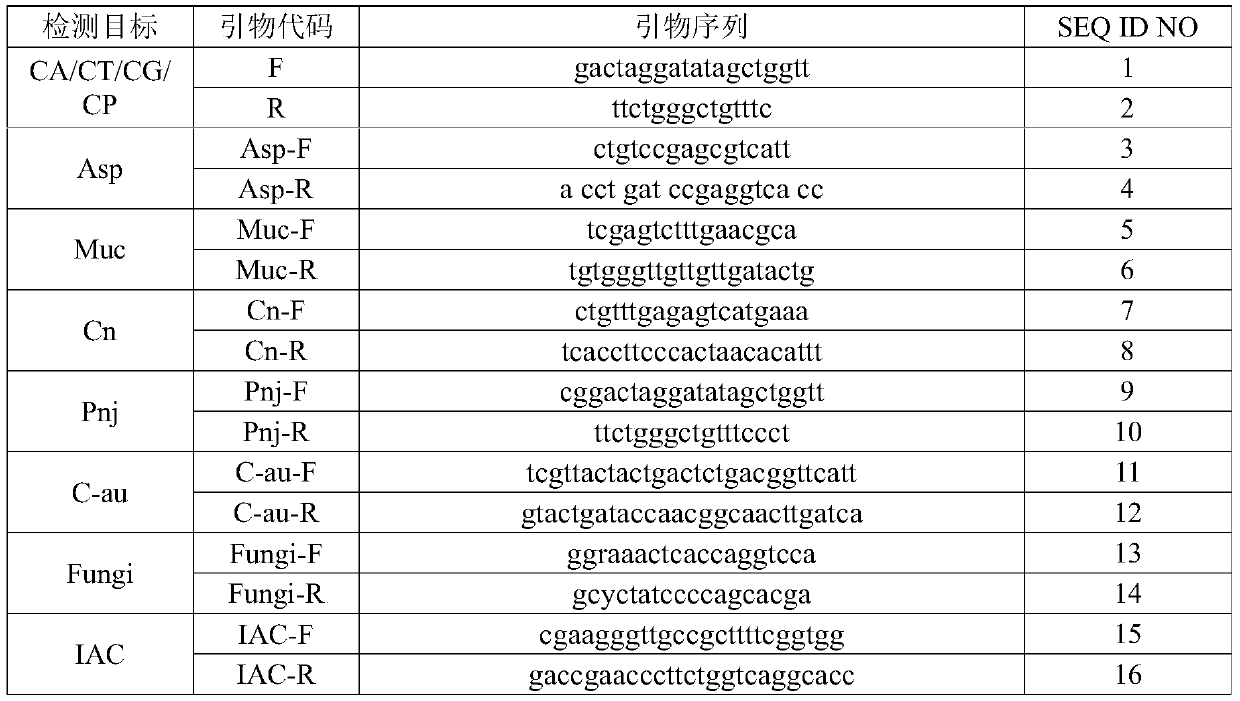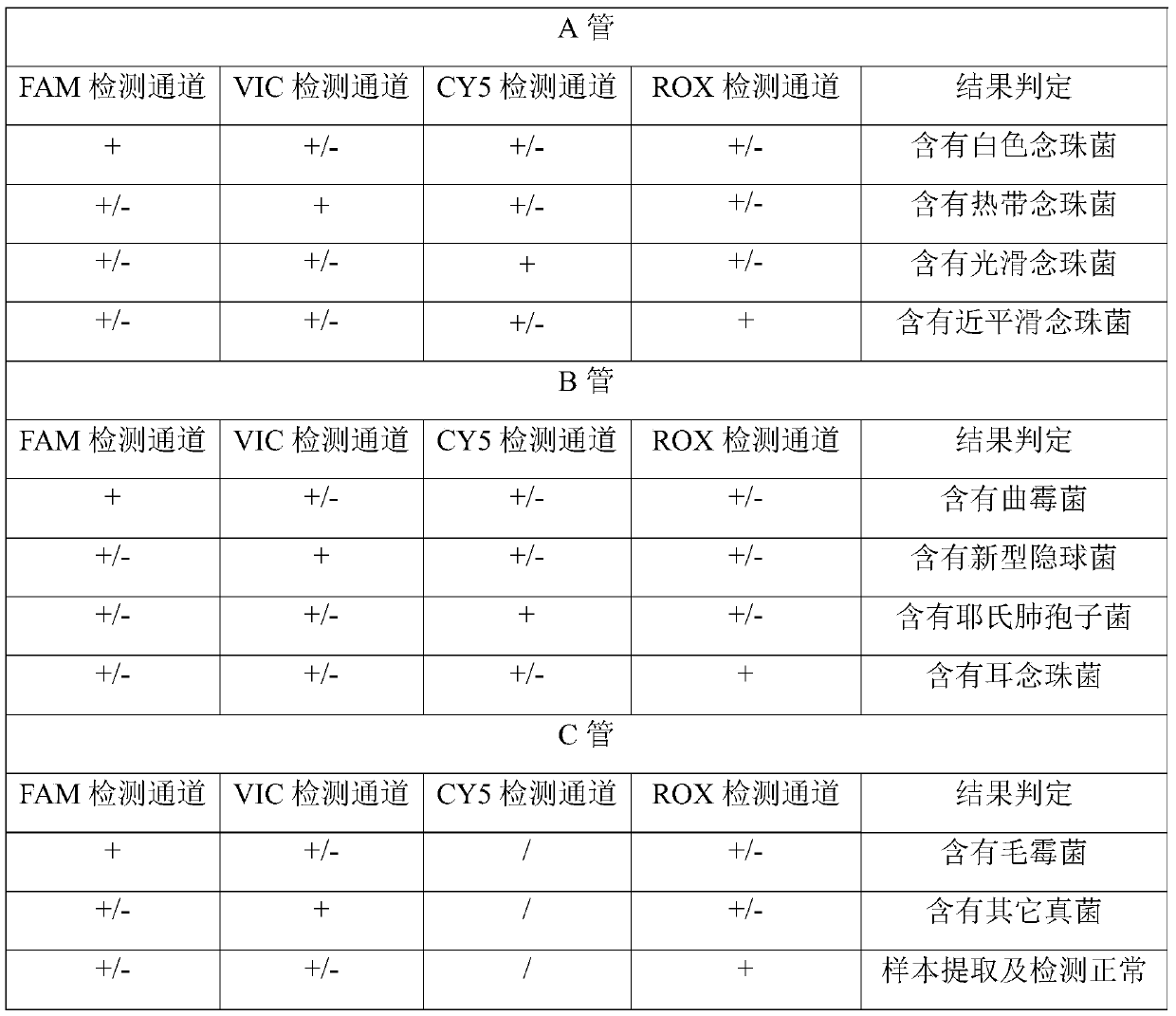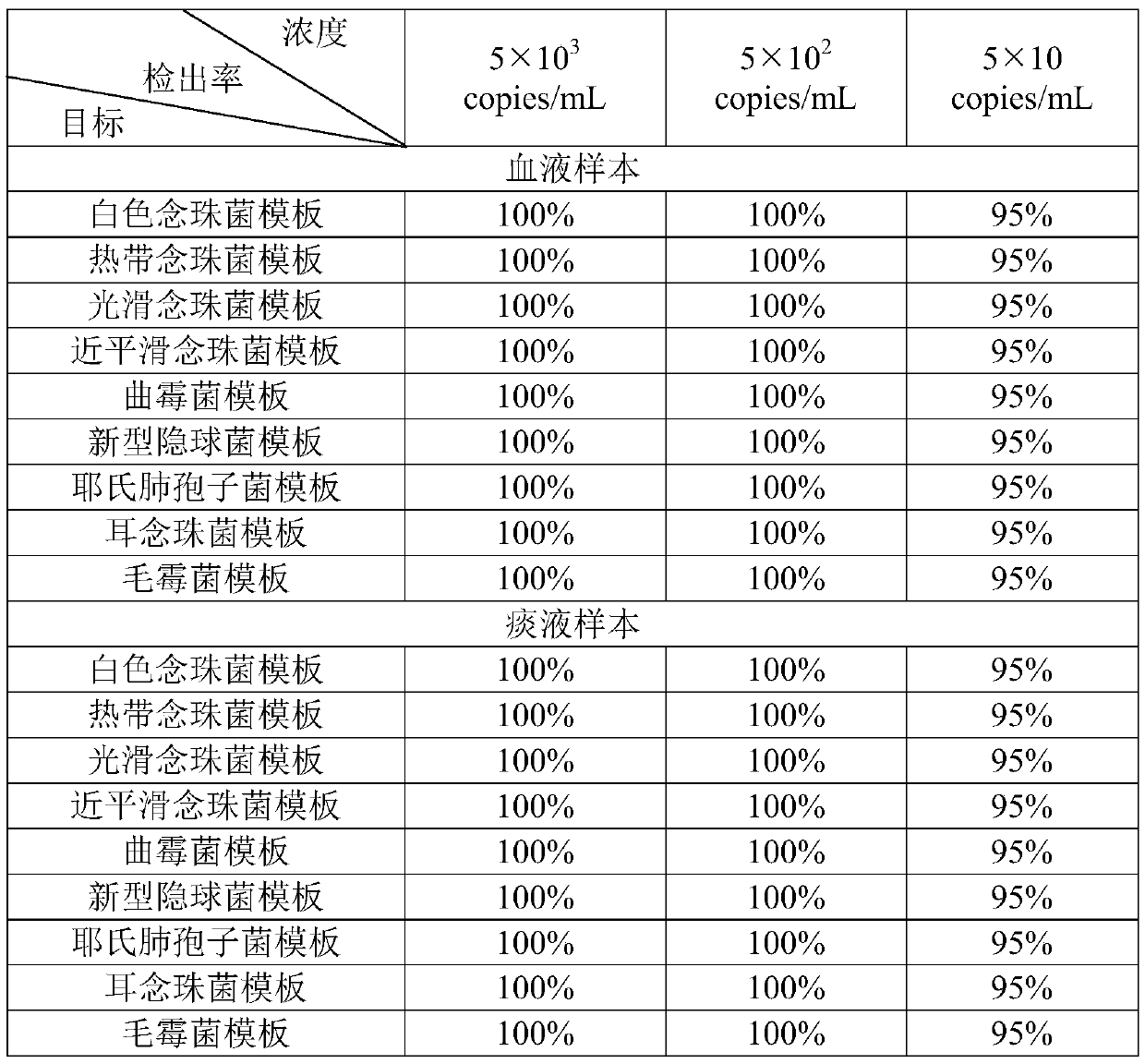Nucleic acid reagent, kit, system and method for detecting invasive fungi
An invasive fungus and kit technology, applied in the biological field, can solve the problems of complex and cumbersome test procedures, increase the complexity of operations, etc., and achieve the effect of overcoming time-consuming and saving time.
- Summary
- Abstract
- Description
- Claims
- Application Information
AI Technical Summary
Problems solved by technology
Method used
Image
Examples
Embodiment 1
[0073] Embodiment 1 detection method and detection result judgment
[0074] 1. Primer and probe synthesis
[0075] Sequence synthesis was performed according to the primer sequences shown in Table 1 and the probe sequences shown in Table 2. In the probe, FAM is 6-carboxyfluorescein, CY5 is 5H-indocyanine, ROX is 6-carboxy-X-rhodamine, VIC is a dye purchased from ABI, and BHQ1-3 is a quenching group.
[0076] Table 1
[0077]
[0078] Table 2
[0079] detection target probe code probe sequence SEQ ID NO CA CA-P FAM-acgtggtggacgttaccgcc-BHQ1 17 CT CT-P VIC-tgtggtggccactagcaaaat-BHQ1 18 CG CG-P CY5-tctgtctrcccagcacgc-BHQ3 19 CP CP-P ROX-caaacccgagggtttgagggagaaa-BHQ2 20 Asp Asp-P FAM-tcctcgagcgtatggggct-BHQ1 21 Muc Muc-P FAM-caacttgcgctcattggta-BHQ1 22 Cn Cn-P VIC-ctcgggttttaytacctgttggactt-BHQ1 23 Pnj Pnj-P CY5-cagacttcttgcgataagg-BHQ3 24 C-au C-au-P ROX-tgtcgttattgttacta...
Embodiment 2
[0099] Embodiment 2 minimum detection limit verification
[0100] Test samples for evaluation: Candida albicans, Candida tropicalis, Candida glabrata, Candida parapsilosis, Mucormyces, Aspergillus, Cryptococcus neoformans, Pneumocystis jirovecii in blood, sputum or alveolar lavage fluid and Candida auris, the respective genomes were extracted by pyrolysis method, and the quantitative concentration was 5×10 4 copies / mL, and then serially diluted to obtain a concentration of 5×10 3 copies / mL, 5×10 2 Copies / mL, 5×10copies / mL evaluation template.
[0101] According to the detection method of Example 1, the evaluation templates of each concentration were detected respectively, and the detection was repeated 20 times for each concentration gradient, and the average value was taken as the final detection result, as shown in Table 4.
[0102] Table 4
[0103]
[0104]
[0105] It can be seen from Table 4 that the minimum detection limit of the genome of the detection target ...
Embodiment 3
[0106] Example 3 specificity verification
[0107]Select human coronavirus (purchased from Wuhan Institute of Virology, Chinese Academy of Sciences, number 2233), cytomegalovirus (purchased from Wuhan Institute of Virology, Chinese Academy of Sciences, number 303), enterovirus (purchased from Wuhan Institute of Virology, Chinese Academy of Sciences, number 977) ), measles virus (purchased from Wuhan Institute of Virology, Chinese Academy of Sciences, number 1513), human metapneumovirus (purchased from Wuhan Institute of Virology, Chinese Academy of Sciences, number 1768), mumps virus (purchased from Wuhan Institute of Virology, Chinese Academy of Sciences, No. 3145), Rhinovirus (purchased from Wuhan Institute of Virology, Chinese Academy of Sciences, No. 2343), Bacillus pertussis (purchased from Wuhan Institute of Virology, Chinese Academy of Sciences, No. 23524), Chlamydia pneumoniae (purchased from Wuhan Institute of Virology, Chinese Academy of Sciences, No. 14127), Mycopla...
PUM
 Login to View More
Login to View More Abstract
Description
Claims
Application Information
 Login to View More
Login to View More - R&D
- Intellectual Property
- Life Sciences
- Materials
- Tech Scout
- Unparalleled Data Quality
- Higher Quality Content
- 60% Fewer Hallucinations
Browse by: Latest US Patents, China's latest patents, Technical Efficacy Thesaurus, Application Domain, Technology Topic, Popular Technical Reports.
© 2025 PatSnap. All rights reserved.Legal|Privacy policy|Modern Slavery Act Transparency Statement|Sitemap|About US| Contact US: help@patsnap.com



